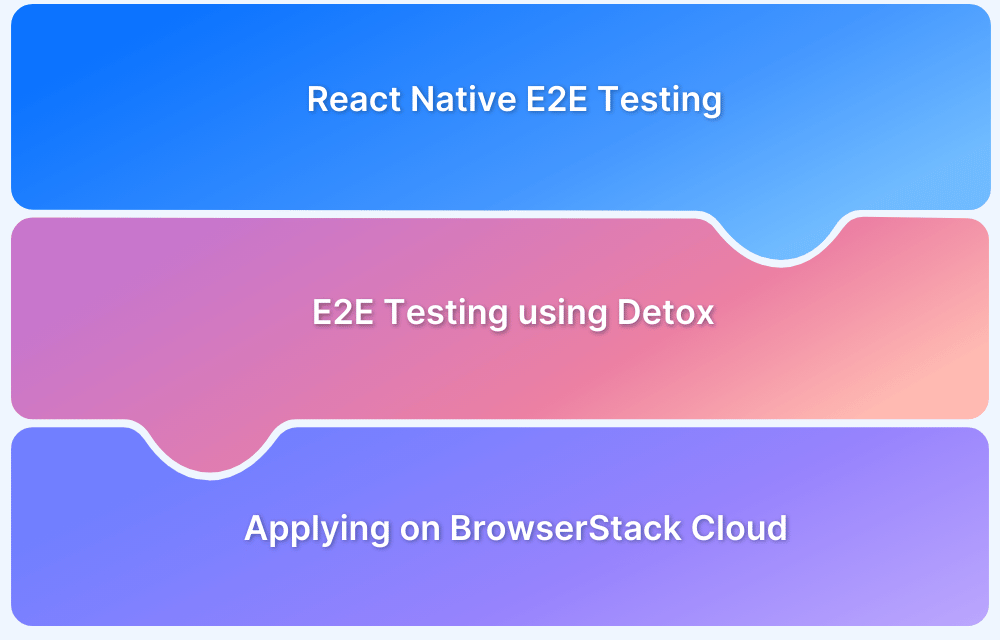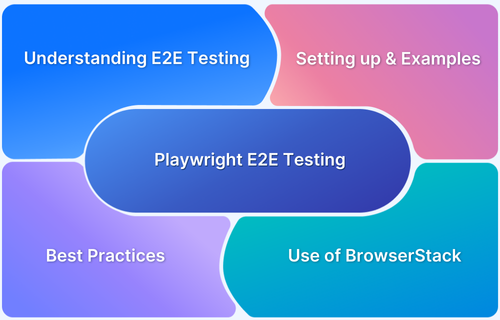Many mobile apps struggle to succeed due to issues missed during design, development, or testing. A significant reason is the lack of proper performance monitoring. End-to-end monitoring covers the entire application stack to ensure smooth performance and helps teams detect problems before users are impacted.
Overview
What is End-to-End Monitoring?
End-to-end (E2E) monitoring tracks the entire user journey across an IT system, providing full visibility to detect issues, remove bottlenecks, and enhance performance and user experience.
Key Aspects of End-to-End Monitoring
- Holistic View: Covers the entire tech stack, user interface, applications, servers, databases, and network layers to offer a unified performance snapshot.
- Comprehensive Data: Combines insights from multiple sources, including real user monitoring (RUM), APM tools, server metrics, and network monitors.
- Actionable Insights: Pinpoints performance issue root causes across systems through data correlation, enabling rapid and informed responses.
- Proactive Approach: Flags anomalies before they impact users, allowing teams to fix problems early and reduce downtime.
- Improved User Experience: By resolving issues across the full stack, E2E monitoring ensures smoother, more reliable user interactions.
Example
When a user clicks a button on a website, E2E monitoring follows the entire chain of events from frontend behaviour to backend processing, capturing data on app performance, network delays, and server load to ensure smooth operation.
Benefits of End-to-End Monitoring
- Faster Troubleshooting: Quick issue detection and resolution with a complete system view.
- Improved Performance: Identifies and optimises system inefficiencies.
- Enhanced User Experience: Ensures consistent, disruption-free performance.
- Proactive Problem Solving: Alerts teams to potential issues before escalation.
- Data-Driven Decisions: Provides insights for system tuning and resource planning.
This article explores what end-to-end monitoring is, why it matters, common misconceptions, best practices, top tools, and tips to debug performance issues effectively.
What is End-User Monitoring?
End-user monitoring involves observing and analyzing the behavior of actual users as they interact with an application. It provides visibility into the actual user experience by capturing data such as page load times, error rates, and transaction flows. This helps teams understand how the application performs under real user conditions.
Unlike traditional monitoring, which focuses on servers or backend components, end-user monitoring highlights issues that directly affect users, such as slow interfaces or broken features. By identifying these problems early, teams can prioritize fixes that improve user satisfaction and retention.
BrowserStack helps teams enhance user experience by enabling functional, visual, and accessibility testing on a wide range of real devices and browsers. It supports end-to-end user flow testing, allowing teams to validate how applications behave across environments before reaching real users.
How End-to-End Monitoring Works
Here is how end-to-end monitoring works to ensure your application runs smoothly and delivers a great user experience:
Data Collection
This step involves gathering comprehensive information from every part of the application’s ecosystem. It includes monitoring user interactions, server responses, database queries, and network performance to ensure no aspect of the user journey is missed.
Data Integration
Once data is collected, it needs to be combined into a single, coherent view. This means merging insights from different layers, such as the frontend interface, backend services, APIs, and infrastructure components, to create a holistic understanding of the application’s health.
Data Analysis
After integration, the data is processed and analyzed to detect unusual patterns or performance drops. This helps pinpoint the root causes of issues, whether it’s a slow response time, increased error rate, or system bottlenecks affecting user experience.
Applying Insights
The final step is to act on the findings. Teams use these insights to troubleshoot and fix problems before they impact users, optimize workflows, and make informed decisions to improve overall application stability and performance.
Importance of End-to-End Monitoring
If you are seeking an End to End monitoring solution, you may come across APM (application performance management).
- APM is about discovering glitches/ anomalies in the mobile app and its elements.
- Tracking the virtual machines, hardware, containers, or infrastructures such as the network, databases, or caches to find bottlenecks and bugs and proposing solutions is its key duty.
- This method only covers system analysis from a technical standpoint – without communication and integration between all those services.
Post-release mobile application monitoring has a massive impact on the overall success of the investment in the newly launched software solution. If this procedure is well thought-through, it:
- Reduces risks/ threats related to downtime, bugs, and other issues
- Gives adherence to post-deployment budget plans
- Guarantees quality control
- Fosters data sharing within the team
- Gives insights into the efficiency and performance of the app
- Enhances visibility into how users use the app in real-time life conditions
Read More: Guide to Enterprise Test Automation
Misconceptions and Myths in End-to-End Monitoring
Many misconceptions exist around monitoring an application’s performance, starting with the terminology itself. Terms like app monitoring, application performance management, chain monitoring, and end-to-end or end-user monitoring are often used interchangeably.
Despite the different names, they all revolve around one core concept: monitoring. With so much information available, it’s important to clarify common misunderstandings. Here are four of the biggest myths about end-to-end monitoring that deserve a closer look.
Read More: What is Digital Experience Monitoring?
- “The application chain will work properly when monitoring all the Apps”
In numerous businesses, monitoring is performed at the application or technical level. This gives a great insight into the individual app’s performance. However, apps are increasingly interlinked and function together to support a single process. With monitoring at the app level, you, therefore, lack insight into the operation of the chain altogether.
- “By outsourcing, means outsourcing the responsibility”
Progressively, enterprises are using operationally critical apps hosted by major Software as a Service (SaaS) parties in the cloud. But the fact that they are offered by giant players like Skype, Dropbox, Microsoft, and Salesforce doesn’t necessarily mean that the apps will perform satisfactorily.
Despite that, countless companies believe that by collaborating with third-party they also pass on the responsibility for better performance. That isn’t true; the core responsibility for the IT service to be offered remains with their own IT department.
Learn More: How DevOps and Cloud work together
- “Measurement is knowledge”
Most companies make some form of effort toward monitoring. Unfortunately, either little is done with the results of the measurements, or the key measurements still say nil about the app performance or app accessibility, or they don’t achieve the desired outcome.
- “The business case for end to end application monitoring is tough to make”
This is a difficult statement but commonly heard. It is true monitoring costs huge bucks. However, if you don’t have insight into the real performance of the complete chain, how can you know when errors exist or are on the way? When sales are deteriorating or when users are starting to complain? Or when business procedures are slowing down? Then it is too late!
You must stay ahead of complaining users or staff and take action before losing them. Here lies the business case for the extra value of end-to-end application monitoring.
Challenges in Implementing End-to-End Monitoring
Implementing end-to-end monitoring can significantly improve application reliability, but it also comes with its share of challenges:
- Complexity of Systems: Modern applications often span multiple services, platforms, and environments, making it difficult to track every component seamlessly. Integrating monitoring across the frontend, backend, APIs, and third-party services requires careful coordination.
- Data Overload: End-to-end monitoring generates vast amounts of data from various sources. Managing, filtering, and making sense of this data to extract actionable insights can be overwhelming without the right tools and processes.
- Integration with Existing Tools: Many organizations already use several monitoring and logging solutions. Ensuring that end-to-end monitoring fits well within existing workflows and integrates with current tools is often a complex task.
- Real-Time Alerting and Accuracy: Setting up alerts that are both timely and accurate is challenging. Too many false positives can lead to alert fatigue, while missed alerts can result in undetected issues affecting users.
- Resource and Skill Requirements: Building and maintaining a robust end-to-end monitoring setup demands skilled personnel and resources. Teams need expertise in various areas, including development, operations, and analytics, to manage the system effectively.
- Cost Considerations: Comprehensive monitoring solutions can be expensive. Organizations need to balance the costs with the benefits of improved performance visibility and faster issue resolution.
Read More: Top 21 Monitoring Tools in DevOps
10 Best Practices for End-to-End Monitoring
By following these 10 best practices, companies can ensure that the monitoring process is successful and aids them in reaching their objectives:
- Choose the right tool for your application monitoring
- Develop a budget and timeline
- Establish clear objectives, goals, and indicators to estimate the success of the project or program. This will ensure that the monitoring process is effective and that any potential hitches can be detected and monitored.
- Developing standardized data collection protocols and procedures to confirm accuracy is key when it comes to the monitoring and evaluation process.
- Use the outputs to make informed decisions.
- Analyzing outcomes and reporting findings. Additionally, it will enable progress monitoring so that any required modifications can be executed along the way.
- Involve all shareholders in the procedure and communicate the results to all stakeholders;
- It is significant to monitor the evaluation procedure periodically to detect if the project is attaining its desired outcomes. This monitoring can be attained through reviews of progress that are conducted frequently.
- It is vital to frequently review and update the monitoring process to ensure it is efficient and effective.
- Don’t be scared to ask for help from your tool vendor. They are the specialists, after all. A good vendor will have extreme support obtainable to you.
It’s crucial that each step of the process is meticulously tracked and any issues or problems addressed decisively and swiftly. You can ensure its successful completion by paying close attention to how the project is systematically progressing and making necessary alterations.
Significant Tools for End-to-End Monitoring
Choosing the right tools is essential for adequate end-to-end monitoring. Here are some widely used options that help cover various aspects of application performance:
- Dynatrace: It offers comprehensive observability combined with continuous runtime application security. Using advanced AI operations, it provides actionable insights and smart automation to simplify complex data and enhance application performance.
- AppDynamics: Helps businesses monitor their technology through the lens of business impact, enabling teams to align IT performance with business priorities and quickly address critical issues.
- Microsoft System Center: Provides a suite of management tools for monitoring, deploying, and managing IT infrastructure. It offers capabilities to oversee physical and virtual environments, ensuring operational efficiency and system health.
- Splunk: Specializes in collecting and analyzing machine-generated data, offering powerful log management and real-time operational intelligence to help identify issues and improve application performance.
- New Relic: Delivers full-stack observability by monitoring applications, infrastructure, and logs in a unified platform. Its AI-driven insights help teams detect and resolve performance issues quickly.
- Pingdom: Focuses on website performance monitoring and synthetic testing to provide uptime alerts and detailed reports on user experience, helping teams keep websites fast and reliable.
Tips for Debugging Your Application’s Performance
There’s no one-size-fits-all solution to performance issues, but adopting two essential approaches can help you avoid delayed responses and ensure a smooth user experience:
- Continuous monitoring with every release
- Performance testing of new features before public launch
Managing the complexities of device fragmentation and maintaining physical device labs can be costly and time-consuming. BrowserStack solves this by providing a cloud-based real device platform that enables interactive testing across 3500+ real device and browser combinations.
Beyond testing, BrowserStack’s Test Reporting & Analytics offers deep insights into test health, failure patterns, and flaky tests, all in one dashboard. With powerful test debugging tools, you can quickly identify the root cause of failures using logs, screenshots, and video recordings, accelerating issue resolution and improving overall software quality.
By leveraging BrowserStack’s integrated platform, teams can confidently monitor, debug, and optimize application performance across diverse environments, ensuring fast, reliable experiences for all users.
Conclusion
Effective application performance monitoring is essential for delivering a seamless user experience and maintaining business success. By combining continuous end-user monitoring with automated testing of critical user flows, organizations can quickly identify and resolve performance bottlenecks before they impact users.
Leveraging modern tools and cloud-based testing platforms simplifies this process, making it scalable, cost-effective, and reliable. Prioritizing automation and smart monitoring strategies ensures your app remains fast, responsive, and ready to meet evolving user expectations.






